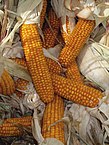Everyone is familiar with weeds, and most people are also aware of the destruction that a particularly invasive weed species can cause to natural environments.
As a result of these invasive plants and the problems they cause, the introduction of new species (of any sort) to a country is often viewed as a bad thing, actively discouraged and controlled. Many countries have strict biosecurity laws, and you cannot bring plants or plant material over the border without the correct permits and paperwork. In some countries it is only registered businesses and research institutions that can do so.
However, before these modern laws and controls were introduced, plants were moved around by people all the time. Sometimes this was on purpose, but it was often accidental as well. There is a lot of talk about the impact of these weed plants, but I feel that less is said about the impact of non-weedy plants that become prevalent in their new home.
What am I talking about? I mean the new crop species that have been moved around the world – such as corn, Zea mays, which is now found much further afield than its original home of South America – and plants for many other uses, like orchids grown for decoration and cotton grown for fibre.

Zea mays – Photograph by H. Zell
Of course, the introduction of these useful plants has had positive impacts on their new countries by providing new industries and better food sources. However, it has also resulted in the reduction or complete cessation of the use of traditional crops. This might not seem like a bad thing. After all, if the traditional crops and methods are less efficient and effective then good riddance! What’s being lost though, is culture. It’s the knowledge of how to use these plants, the unique industries around them, the unique cuisine.
An example I recently encountered here in Laos involves the ubiquitous chilli pepper. Lao food, like that of most Asian nations, uses liberal amounts of chilli in many dishes. Lao people love their food hot, hot, hot! I’ve often wondered what they used to use before chillies were introduced from South America, or if Lao food was perhaps just not spicy traditionally. It turns out that a local species of pepper, Piper retrofractum, known as “Dee Pee” in Lao, was the original spice. I can’t help but wonder how using Dee Pee would alter the flavour of Lao dishes and make them more unique. Piper retrofractum is now quite difficult to get hold of. Several of our staff at PTK recall growing up with it around their village, but say there’s none there now. I never see it here in Luang Prabang, I’ve never eaten it, and most younger locals I speak to have never cooked with it or eaten it either.

Piper retrofractum – Photograph by Meneerke Bloem
I find it a bit sad that in such a short space of time (a single generation) the knowledge on how to use and grow this plant has been lost. This is unfortunately symptomatic of a wider problem, with ethno-botanical knowledge being lost left, right and centre. At Pha Tad Ke we are focused on ensuring the preservation of this traditional plant knowledge, and there are other wonderful organisations in Laos also working to ensure this information isn’t lost (there is particular interest around the traditional textiles industry). There’s no denying that the task ahead of us is great though, and that it’s a challenge in this increasingly connected, amalgamated, global world.
I hope to taste some Lao food cooked with Dee Pee sometime soon – perhaps I’ll handle it better than I do the chilli…
By Bryony Smart, PTK Botanist
Photographs from Wikimedia Commons:
Zea mays: By H. Zell – Own work, CC BY-SA 3.0, https://commons.wikimedia.org/w/index.php?curid=11484113
Piper retrofractum: By Meneerke Bloem – Own work, CC BY-SA 3.0, https://commons.wikimedia.org/w/index.php?curid=8754582


